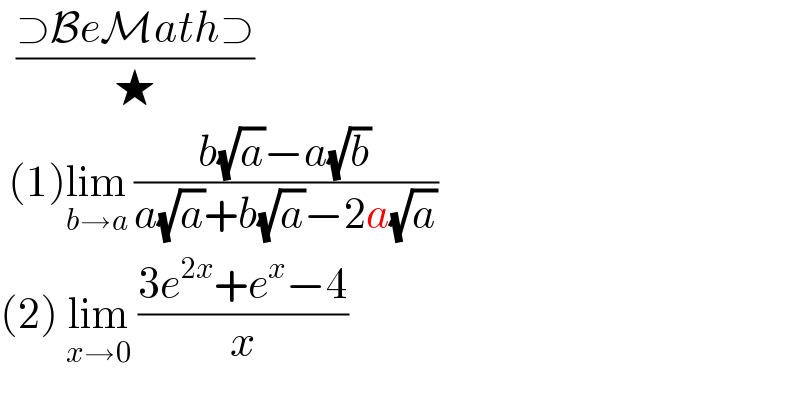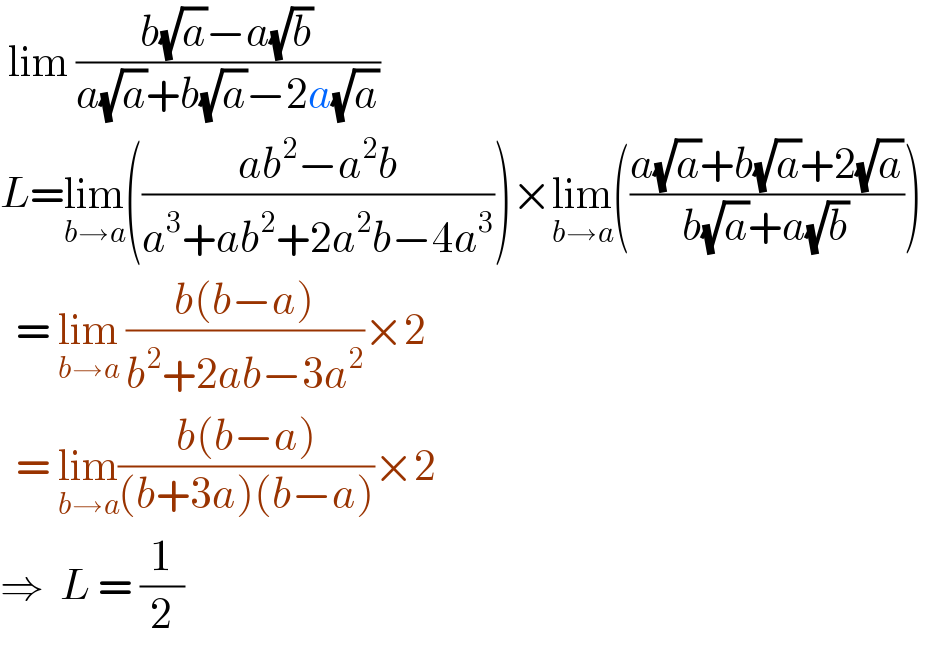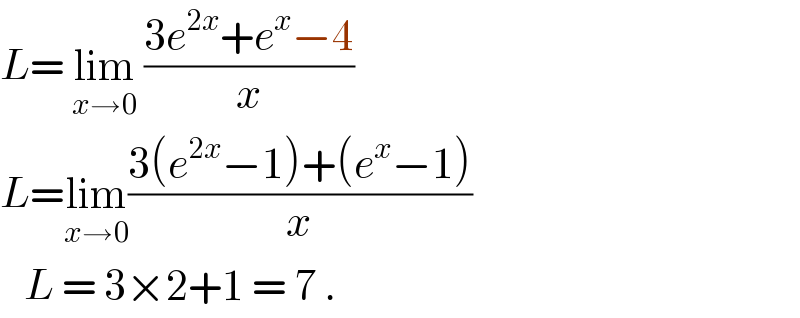
Question Number 108623 by bemath last updated on 18/Aug/20

$$\:\:\frac{\supset\mathcal{B}{e}\mathcal{M}{ath}\supset}{\bigstar} \\ $$$$\:\left(\mathrm{1}\right)\underset{{b}\rightarrow{a}} {\mathrm{lim}}\:\frac{{b}\sqrt{{a}}−{a}\sqrt{{b}}}{{a}\sqrt{{a}}+{b}\sqrt{{a}}−\mathrm{2}{a}\sqrt{{a}}} \\ $$$$\left(\mathrm{2}\right)\:\underset{{x}\rightarrow\mathrm{0}} {\mathrm{lim}}\:\frac{\mathrm{3}{e}^{\mathrm{2}{x}} +{e}^{{x}} −\mathrm{4}}{{x}} \\ $$
Answered by ajfour last updated on 18/Aug/20

$$\:\mathrm{lim}\:\frac{{b}\sqrt{{a}}−{a}\sqrt{{b}}}{{a}\sqrt{{a}}+{b}\sqrt{{a}}−\mathrm{2}{a}\sqrt{{a}}} \\ $$$${L}=\underset{{b}\rightarrow{a}} {\mathrm{lim}}\left(\frac{{ab}^{\mathrm{2}} −{a}^{\mathrm{2}} {b}}{{a}^{\mathrm{3}} +{ab}^{\mathrm{2}} +\mathrm{2}{a}^{\mathrm{2}} {b}−\mathrm{4}{a}^{\mathrm{3}} }\right)×\underset{{b}\rightarrow{a}} {\mathrm{lim}}\left(\frac{{a}\sqrt{{a}}+{b}\sqrt{{a}}+\mathrm{2}\sqrt{{a}}}{{b}\sqrt{{a}}+{a}\sqrt{{b}}}\right) \\ $$$$\:\:=\:\underset{{b}\rightarrow{a}} {\mathrm{lim}}\:\frac{{b}\left({b}−{a}\right)}{{b}^{\mathrm{2}} +\mathrm{2}{ab}−\mathrm{3}{a}^{\mathrm{2}} }×\mathrm{2} \\ $$$$\:\:=\:\underset{{b}\rightarrow{a}} {\mathrm{lim}}\frac{{b}\left({b}−{a}\right)}{\left({b}+\mathrm{3}{a}\right)\left({b}−{a}\right)}×\mathrm{2} \\ $$$$\Rightarrow\:\:{L}\:=\:\frac{\mathrm{1}}{\mathrm{2}}\: \\ $$
Commented by bemath last updated on 18/Aug/20

$${cooll} \\ $$
Answered by ajfour last updated on 18/Aug/20

$${L}=\:\underset{{x}\rightarrow\mathrm{0}} {\mathrm{lim}}\:\frac{\mathrm{3}{e}^{\mathrm{2}{x}} +{e}^{{x}} −\mathrm{4}}{{x}} \\ $$$${L}=\underset{{x}\rightarrow\mathrm{0}} {\mathrm{lim}}\frac{\mathrm{3}\left({e}^{\mathrm{2}{x}} −\mathrm{1}\right)+\left({e}^{{x}} −\mathrm{1}\right)}{{x}} \\ $$$$\:\:\:{L}\:=\:\mathrm{3}×\mathrm{2}+\mathrm{1}\:=\:\mathrm{7}\:. \\ $$
Answered by mathmax by abdo last updated on 18/Aug/20

$$\left.\mathrm{2}\right)\:\mathrm{f}\left(\mathrm{x}\right)=\frac{\mathrm{3e}^{\mathrm{2x}} +\mathrm{e}^{\mathrm{x}} −\mathrm{4}}{\mathrm{x}}\:\:\mathrm{we}\:\mathrm{hsve}\:\mathrm{e}^{\mathrm{2x}} \:\sim\mathrm{1}+\mathrm{2x}\:\:\mathrm{and}\:\mathrm{e}^{\mathrm{x}} \:\sim\mathrm{1}+\mathrm{x}\:\Rightarrow \\ $$$$\mathrm{f}\left(\mathrm{x}\right)\sim\frac{\mathrm{3}+\mathrm{6x}+\mathrm{1}+\mathrm{x}−\mathrm{4}}{\mathrm{x}}\:=\mathrm{7}\left(\mathrm{x}\rightarrow\mathrm{0}\right)\:\Rightarrow\mathrm{lim}_{\mathrm{x}\rightarrow\mathrm{0}} \mathrm{f}\left(\mathrm{x}\right)=\mathrm{7} \\ $$
